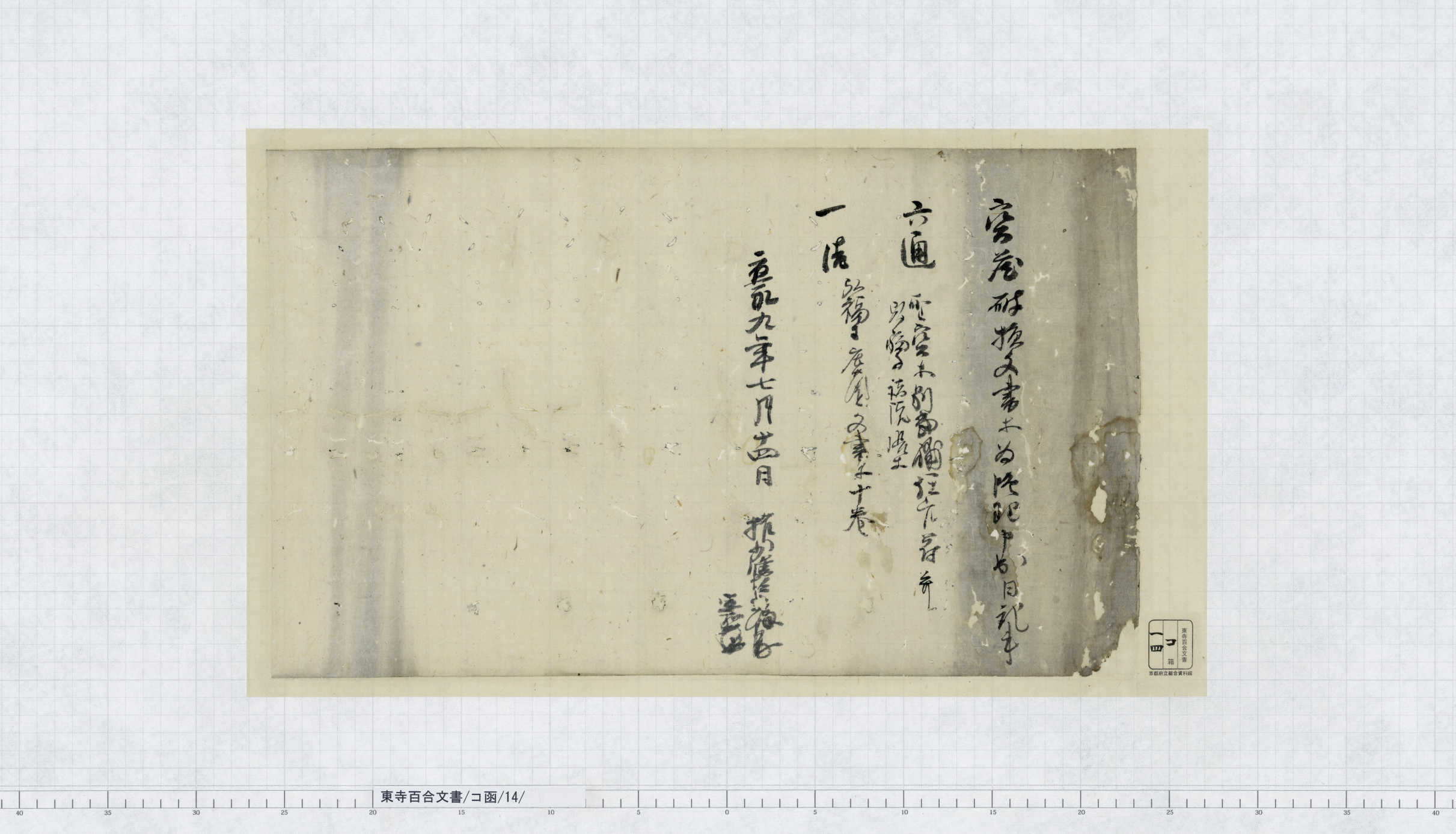
The document above is a record of documents removed from the treasure house for restoration work in 1402, around the middle of the Muromachi period. The document reveals that six documents and a bound book were removed from the treasure house. One of the six documents was “Shobo-betto Bunin-kanpu (聖宝別当補任官符),” an official document appointing Shobo, a monk who founded Daigo-ji Temple, to a position called bonso-betto (凡僧別当, head monk) of Toji in 902. Toji had preserved this 500-year-old document and restored it for future use. Toji had a strict management system to preserve and utilize its documents.
Toji had internal monastic organizations with names mostly ending in “-kata (方),” including Nijuikku-kuso-kata (廿一口供僧方) and Chinjuhachimangu-kata (鎮守八幡宮方). They functioned as semi-independent organizations while also serving as units of one large temple, Toji. Each monastic organization issued not only documents directly related to Buddhism, including Buddhist sutras and documents concerning rituals, but also a great deal of documents related to the operation and management of the organization, including documents about manors, which provided major financial resources for the execution of Buddhist services, and meeting minutes, referred to as hyojo-hikitsuke (評定引付).
Most of the documents were housed in the library of Sai-in Mieido (西院御影堂), a temple famous for its association with Kukai (空海), also known as Kobo-daishi (弘法大師). The bugyo (奉行, also called nengyoji or nenyo), who directed the clerical operations of a monastic organization, was solely responsible for the management of documents. The bugyo’s work included signing official documents issued by the organization, drawing up anmon (manuscript copies) and hyojo-hikitsuke, and listing documents brought by other monastic organizations or institutions.
Document storage boxes of each monastic organization were housed in the library of Sai-in. Although its number varied according to the period, there were a large number of document storage boxes including the following:
Shomon Jo Kawako (正文上皮子)
Shomon Ge Kawako (正文下皮子)
Nijuikku-kata Kawako (廿一口方皮子)
Nijuikku-kata Daiichi-bako (廿一口方第一箱)
Nijuikku-kata Daini-bako (廿一口方第二箱)
Nijuikku-kata Daisan-bako (廿一口方第三箱)
Nijuikku-kata Daiyon-bako (廿一口方第四箱)
Juhakku-kata Kawako (十八口方皮子)
Oyama Bako (大山箱)
Kamikatsura Bako (上桂箱)
Tara-no-sho Daiichi Kawako (太良庄第一皮子)
Tara-no-sho Daiichi-bako (太良庄第一箱)
Tara-no-sho Daini-bako (太良庄第二箱)
Gakushu-kata Daiichi-bako (学衆方第一箱)
Gakushu-kata Daini-bako (学衆方第二箱)
Kuze-kata Bako (久世方箱)
Kishinden Jo Bako (寄進田上箱)
Kishinden Chu Bako (寄進田中箱)
Kishinden Ge Bako (寄進田下箱)
Ukebumi Bako (請文箱)
Zoei-kata Bako (造営方箱)
Soji-kata Bako (掃除方箱)
Shibuhari Bako (シブハリ箱)
*Restored from “Sai-in Monjo Suito-cho (西院文書出納帳)” (Item (19) of Tenchi-no-bu, Item (86) of Box-kyo, Item (94) of Box-ri, Item (30) of Box-na, Item (43) of Box-a, Item (55) of Box-a, Item (111) of Box-sa, Item (113) of Box-sa, and Item (126) of Box-sa). These documents contain information about the 15th and 16th centuries.

The document above is a catalog of the contents of “Gakushu-kata Daiichi-bako (the first box of Gakushu-kata),” which appears in the list mentioned earlier. The catalog includes 27 items, the first 14 items of which appear to have been stored in a wicker basket as specially valued treasures. The first volume of “Go-Uda-in Shikajo Gokishin Gokisho-fu (後宇多院四ヶ庄御寄進御起請符)” listed at the top of the catalog was separately stored in another box. The documents listed in this catalog were important certificates of land rights, which are described as “jusho (重書, important documents)” in the first line of the document.

The document above is also a catalog of the contents of “Gakushu-kata Daini-bako (the second box of Gakushu-kata).” The catalog includes “Gakushu Monjo-ko-mokuroku Ikkan (the first volume of old catalogs of documents of Gakushu-kata),” indicating that Gakushu-kata had already been managing their documents by cataloging since even earlier times.
The bugyo of each monastic organization kept its important documents in special document storage boxes called tefumibako (手文箱) and kept them close at hand. The tefumibako were handed over to the next bugyo when the previous bugyo had served out his one-year term of service. The document below, referred to as soshin-jo, contains information about items handed over to the new bugyo. According to the document, the key and chain to lock the treasure house and keys to Yotsuashi Gate and Nishi Gate, which opened into passages to Mieido, were handed over to the new bugyo with the tefumibako. Although there were monks called sanshonin and kadosashi who controlled entry to and exit from the library and the gates, the keys to these facilities were under the control of the bugyo. This indicates how significant the bugyo’s duty as a manager of documents was considered. The document is dated December 29. The tefumibako and necessary items of Nijjuikku-kata were handed over to the new bugyo at the end of the year, and the position of the bugyo was officially transferred in the new year.


The document above is a soshin-jo drawn up 50 years after Item (200) of Box-a. The document reveals that the number of tefumibako of Nijuikku-kata had increased from 9 to 14.